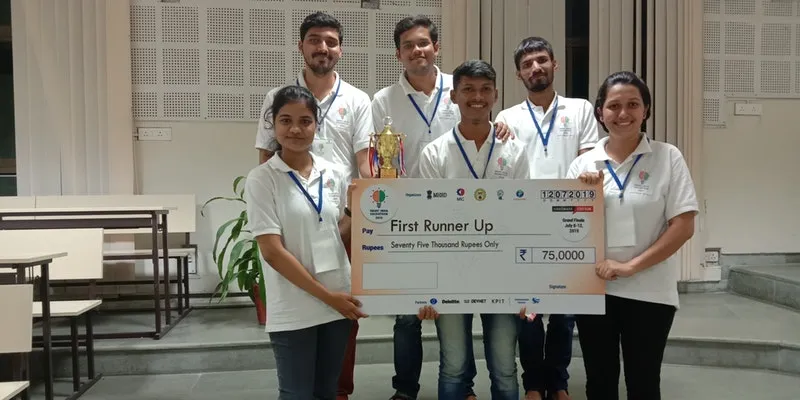Inspired by NASA’s Curiosity Robot, engineering students and grads team up to design a surveillance rover for the Army
Three engineering graduates got together with three IT students to develop a multi-terrain surveillance rover without human interference that also self-destructs and shoots intruders.
It’s what everyone in India is talking about. Terrorism and revoking Article 370 has brought Jammu and Kashmir into the limelight again. But, it was in 2016, after the Pathankot and Uri attacks, that six engineering students decided to explore the need for a safe and secure surveillance vehicle.
Team Shaurya created the Surveillance Rover that can help the Army in data collection. They were the finalists of the Smart India Hackathon under the theme ‘Security and Surveillance,’ at their nodal centre IIT Roorkee, and also won a cash prize of Rs 75,000.
“The incidents (Pathankot and Uri), and the death of so many soldiers affected me deeply. I wanted to use my knowledge and skills for the benefit of the Army,” says team lead Raj Gandhi (22), a graduate from Bharati Vidyapeeth College of Engineering, Navi Mumbai.

Team Shaurya
How it all started
When Raj saw a video of the Curiosity Rover developed by NASA for the Mars mission, he was excited, and came up with the idea to develop something similar for the Indian Army. Raj, along with friends from college - Shivraj Jadhav (22), Aniket Jhadhav (22), Mayur Shinde (21), Bhagyashree Sarode (21) and Khushboo Singh (21) – all from Bharati Vidyapeeth College of Engineering, Navi Mumbai, formed Shaurya last year to work on this idea using Rocker Bogie mechanism (a rover with no springs or stub axles for each wheel which allows it to climb over any obstacle).
The team built a ground surveillance rover with the objective of providing a reliable mechanism for security and surveillance. The rover is equipped with sensors that can track information like temperature, humidity, amount of gases in the environment, and it can even tilt. Additionally, it has a GPS module embedded to track its movement.
“We have built a mobile application for controlling the mechanism of the rover. The data gathered from the sensors is available on the application for analysis, and the application is password protected,” says Raj.
The rover also has a camera-assisted gun mechanism that can be controlled manually as well as automatically, with user consent to shoot harmful intruders. It is also equipped with radio frequency jamming to block enemy communication.
“The rover is also equipped with a software-based self-destruction feature to maintain data secrecy in case it is spotted by enemies,” Raj says.
While three of the team members (Raj, Shivraja and Aniketare) graduates in mechanical, the rest of the team – Mayur, Bhagyashree and Khushboo are in the fourth year of Information Technology. The mechanical engineering students built the rover, the gun, and the self-destruction mechanism. However, they needed help from the IT whizzes to build an integrated mobile application that controls the rover.
“We got together after our college faculty suggested we team up for the development of the complete product,” Raj says.
The team initially faced many challenges - maintaining the centre of gravity, interfacing the rover with an Android application, and procuring required materials. They had to import the wheels from China as the ones available in India were not appropriate. Raj says that each wheel costs Rs 500.
They spent Rs 17,000 to build the entire product. The team has, however, not decided on the final price of the product.

Surveillance Rover built by team Shaurya
Getting the rover to be IoT-competent
Team Shaurya has used internet-of-things, machine learning, Android development and Rapid Prototyping technology to build the rover. The Surveillance Rover can climb rocks, inclined planes, uneven surfaces, tree roots and even get by in loose muddy soil.
It can send real time data to the operator, including its location, “Thus, it successfully fulfilled our objective of multi-terrain surveillance without human interference,” says Raj.
Looking to the future, the team says that the rover has the scope of adding a solar panel to aid in power management and a night vision camera for better navigation after sunset. They also want to develop a storage system to transfer the data to cloud.
“We have successfully solved the problem that our military currently faces, which is providing an alternative to the tank chassis (belt-driven-based mechanism) with our rover,” Raj says. "The mechanism that we have used may be available in the market, but as far as we know, this kind of mechansim has never been used in the defence sector."
The team plans to launch the product in the market or propose its use to the government. “However, as of now we have been unable get in touch with anyone from the government,” Raj says.
To instill and foster innovation among students, the Central government started the Smart India Hackathon (SIH) in 2017, and recently concluded the third edition successfully. YourStory brings to you some amazing young minds and their innovations which solve many of the country’s issues across various streams.
(Edited by Suruchi Kapur-Gomes)









